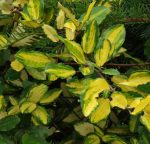 This vine-like sprawling evergreen shrub, also known as thorny olive, spiny oleaster, and silverthorn is native to China and Japan. It is a member of the oleaster family, Eleagnaceae, that also includes sea buckthorn. Plants grow 12-15′ tall by 15-18′ wide and are densely branched with stems that are covered with brown scales and usually have spines 2-3″ long. The elliptical to oblong leaves are 2-4″ long, have wavy margins, and are variegated green with white or yellow above and covered with silvery scales below. Both the the main veins and petiole are covered with brown scales. In the fall, axillary clusters of 2-3 very fragrant, silvery white flowers appear. The inconspicuous flowers are 1/4″ long, lack petals, and are bell-shaped. The one-seeded fleshy fruits are 1/2″ across, reddish brown when they ripen in the spring, and are attractive to birds. Many cultivars are available. Thorny eleagnus is tolerant of heat, drought, salt and pollution so can be used in xeriscapes, urban plantings, and seaside gardens. It can be sheared into a formal hedge and can be used as a screen, windbreak, or for erosion control as well as for bonsai. Unfortunately, it is a very vigorous grower and can become invasive, forming dense thickets that crowd out native species. The genus name, Elaeagnus, comes from the Greek words elaia, meaning olive tree, and agnos meaning chaste. The specific epithet, pungens, is the Latin word meaning sharp pointed and refers to the spines on the branches.
This vine-like sprawling evergreen shrub, also known as thorny olive, spiny oleaster, and silverthorn is native to China and Japan. It is a member of the oleaster family, Eleagnaceae, that also includes sea buckthorn. Plants grow 12-15′ tall by 15-18′ wide and are densely branched with stems that are covered with brown scales and usually have spines 2-3″ long. The elliptical to oblong leaves are 2-4″ long, have wavy margins, and are variegated green with white or yellow above and covered with silvery scales below. Both the the main veins and petiole are covered with brown scales. In the fall, axillary clusters of 2-3 very fragrant, silvery white flowers appear. The inconspicuous flowers are 1/4″ long, lack petals, and are bell-shaped. The one-seeded fleshy fruits are 1/2″ across, reddish brown when they ripen in the spring, and are attractive to birds. Many cultivars are available. Thorny eleagnus is tolerant of heat, drought, salt and pollution so can be used in xeriscapes, urban plantings, and seaside gardens. It can be sheared into a formal hedge and can be used as a screen, windbreak, or for erosion control as well as for bonsai. Unfortunately, it is a very vigorous grower and can become invasive, forming dense thickets that crowd out native species. The genus name, Elaeagnus, comes from the Greek words elaia, meaning olive tree, and agnos meaning chaste. The specific epithet, pungens, is the Latin word meaning sharp pointed and refers to the spines on the branches.
Type: Evergreen shrub
Outstanding Feature: Foliage, very fragrant flowers
Form: Sprawling
Growth Rate: Rapid
Bloom: Axillary clusters of 2-3 bell-shaped, very fragrant flowers in fall
Size: 12-15′ H x 15-18′ W
Light: Full sun to part shade
Soil: Average, medium moist, well-drained but tolerates lean, dry soil.
Hardiness: Zones 7-9
Care: Cut back side shoots to encourage colorful new growth; can be sheared inot formal hedge. Plants spread easily and need containment in most places.
Pests and Diseases: Generally healthy but susceptible to fungal leaf spot, rust, spider mites
Propagation: Cuttings, layering, seed
Outstanding Selections:
‘Maculata’ (yellow edged with green)
‘Chirifu’ (green speckled with gold)
‘Fredricii’ (green with white)